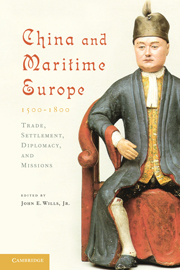Book contents
- Frontmatter
- Contents
- Contributors
- Preface
- Conventions
- Introduction
- 1 Maritime Europe and the Ming
- 2 Learning from Heaven: The Introduction of Christianity and Other Western Ideas into Late Ming China
- 3 Catholic Missions and the Expansion of Christianity, 1644–1800
- 4 Trade and Diplomacy with Maritime Europe, 1644–c. 1800
- Bibliography
- Index
4 - Trade and Diplomacy with Maritime Europe, 1644–c. 1800
Published online by Cambridge University Press: 05 June 2012
- Frontmatter
- Contents
- Contributors
- Preface
- Conventions
- Introduction
- 1 Maritime Europe and the Ming
- 2 Learning from Heaven: The Introduction of Christianity and Other Western Ideas into Late Ming China
- 3 Catholic Missions and the Expansion of Christianity, 1644–1800
- 4 Trade and Diplomacy with Maritime Europe, 1644–c. 1800
- Bibliography
- Index
Summary
The connections summarized in this chapter show the early and middle Qing Empire involved in global changes. Tea from China was one of the transoceanic consumer goods that helped to stimulate the steady growth of intercontinental maritime connections and the emergence in northwestern Europe of prosperous and dynamic bourgeois societies. Chinese porcelain was less important in trade-value terms but very important for European consumption patterns and rêves chinois. The export of tea shaped several sectors of the south Chinese economy, provided a convenient flow of revenue for the imperial household, and drew an inflow of silver vital to the monetization of the Chinese economy. By 1780–1800 other waves of world-historical change were reaching Fujian and Guangdong: ships from the new United States, some of them bringing Pacific sea otter skins and Hawaiian sandalwood; and private traders from the emerging British Empire in India bringing opium. The Qing rulers viewed these maritime connections with trepidation, recalling the early Qing–Ming loyalist resistance along the coast and never sure of the loyalty of Chinese settled in Southeast Asian ports. The maritime Chinese returned the distrust; very little of their rich knowledge of European and Southeast Asian trading partners made its way into print or into the files of the Qing bureaucracy. Qing wariness of the cultural contamination brought by Roman Catholic missionaries sometimes affected their attitudes toward European traders, especially the Portuguese of Macao. The result was a China involved in an interactive early modern world in a variety of ways but with a ruling elite largely in denial, especially about the maritime connections. In the great trade at Canton, the traders and the Qing got what they wanted with a minimum of exchange of opinion and information and almost no foreign travel within the empire. Europeans could and did trade without sending tribute embassies to Beijing.
Early Qing, 1644–1690
The patterns of relations with maritime Europeans in the 1690s were different from what they had been in the 1630s. The changes in the intervening decades cannot be understood without attention to the stages of Qing conquest and dynastic consolidation, but some of the most striking changes, like the Zheng conquest of Taiwan, were peripheral to that process or, like the expulsion of the Portuguese from Japan, were completely unrelated to it. Macao survived the immense blow of the exclusion from Japan, strengthened its trading connections with the sandalwood islands of eastern Indonesia, and eventually emerged as an important center of the Indian Ocean–South China Sea “country trade” of the eighteenth century. However, it did not recover its earlier prosperity or its centrality in Sino-European relations. The Dutch and Zheng Zhilong, sometimes competing and sometimes cooperating, were not slow to take advantage of the immense opportunity for trade with Japan presented to them by the collapse of the expulsion of the Portuguese. They already had begun to expand their trade to Nagasaki as the Portuguese position there disintegrated in the late 1630s and continued to do so in the early 1640s. Quantities of Sino-Japanese trade between 1644 and the reopening of Qing maritime trade in 1684 are difficult to sort out.
- Type
- Chapter
- Information
- China and Maritime Europe, 1500–1800Trade, Settlement, Diplomacy, and Missions, pp. 183 - 254Publisher: Cambridge University PressPrint publication year: 2010
- 3
- Cited by



